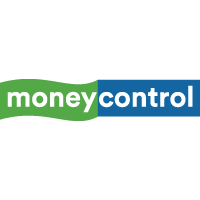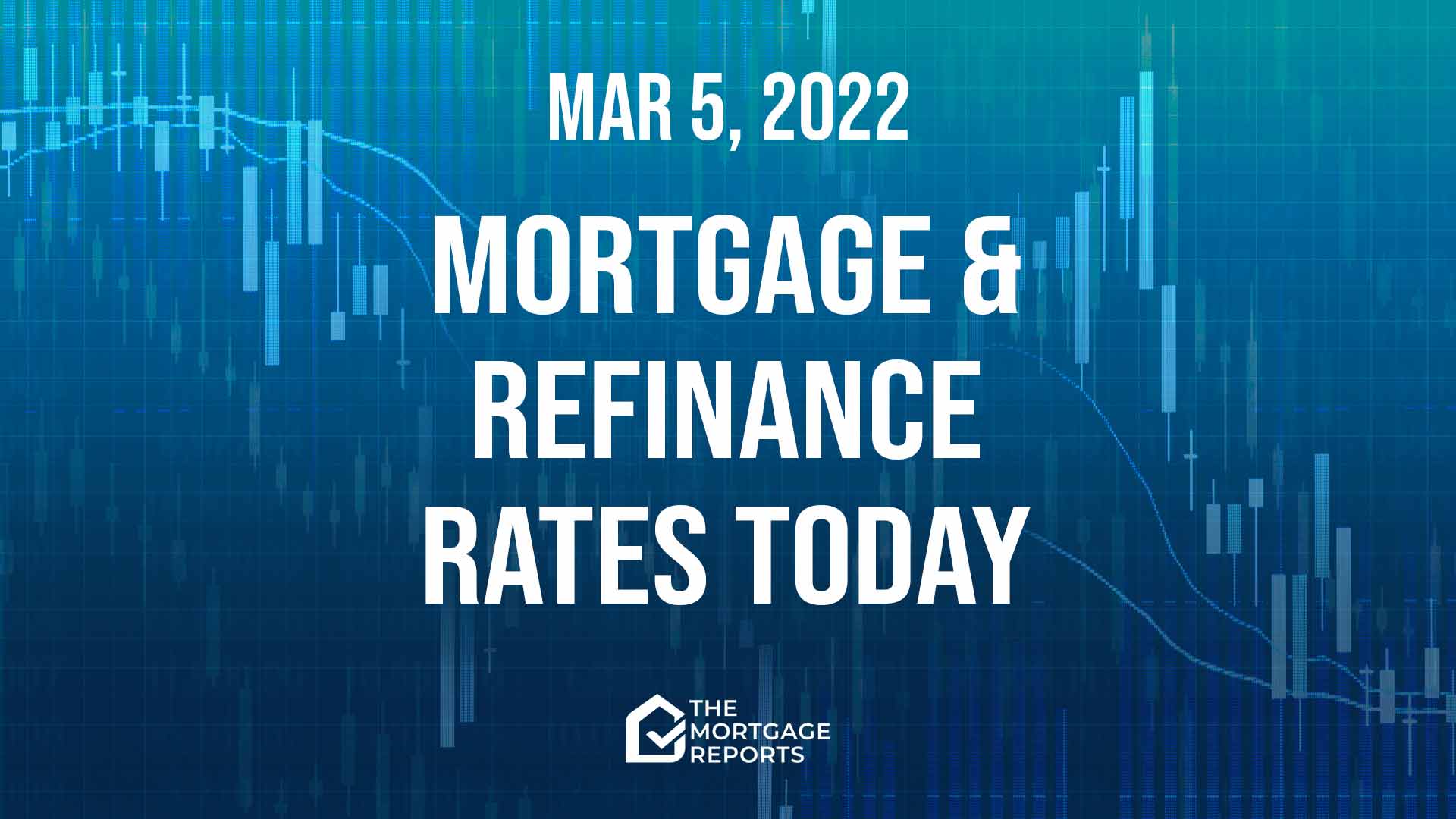Today’s Mortgage and Refinance Rates
Average mortgage rates fell sharply yesterday. And this week has been good for those rates.
I suspect that the next seven days will be less good and that mortgage rates could rise next week. But so much depends on unpredictable events in Ukraine that I already half expect to be wrong.
Current mortgage and refinance rates
| Program | Mortgage rate | APR* | Change |
|---|---|---|---|
| 30-year fixed conventional | 3.95% | 3.974% | -0.11% |
| 15-year fixed conventional | 3.321% | 3.355% | -0.07% |
| 20-year fixed conventional | 3.805% | 3.839% | -0.13% |
| 10-year fixed conventional | 3.21% | 3.278% | -0.11% |
| 30-year fixed FHA | 4.167% | 4.93% | -0.07% |
| 15-year fixed FHA | 3.591% | 4.213% | -0.1% |
| 5/1 ARM FHA | 4.75% | 4.621% | Unchanged |
| 30-year fixed PV | 4.136% | 4.344% | -0.08% |
| 15-year fixed VA | 3.213% | 3.542% | Unchanged |
| 5/1 ARM GO | 4.75% | 3.754% | Unchanged |
| Pricing is provided by our partner network and may not reflect the market. Your rate may be different. Click here for a personalized quote. See our rate assumptions here. | |||
Should you lock in a mortgage rate today?
I wouldn’t lock in my mortgage rate today if I were you. These rates are significantly better than they were at this time last week.
But I’d be willing to push the button on Monday morning – or rather the first morning when rates look likely to rise significantly.
This is because I feel (no more than that) that the markets have already priced in the economic impact of Russia’s invasion of Ukraine. The end result, a Russian victory, seems a foregone conclusion to most military experts, simply because the invader has overwhelmingly superior firepower. Read on for more discussion.
Nevertheless, in the longer term, my personal rate lock recommendations remain:
- LOCK if closing 7 days
- LOCK if closing 15 days
- LOCK if closing 30 days
- LOCK if closing 45 days
- LOCK if closing 60 days
However, with so much uncertainty right now, your instincts could easily turn out to be as good as mine, or even better. So let your instincts and personal risk tolerance guide you.
What’s Moving Current Mortgage Rates
Ukraine
You can see how strangely the markets reacted to Russia’s invasion of Ukraine and the ensuing sanctions from the international community.
Looking back in Mortgage News Daily’s rate archives, there was little reaction to the invasion itself. But Monday and Tuesday saw steep falls, apparently in response to unexpectedly harsh sanctions and soaring oil prices. Then there was an even bigger rise on Wednesday, followed by a very small one the next day. The surprise came yesterday when they dived again.
Of course, yesterday’s drop came as no surprise in some ways. It was triggered by the bombing by Russian forces of Zaporizhzhia, the largest nuclear power plant in Ukraine (and Europe). The markets were prepared for the brutality of the invading army, but not for such silence. And it rattled investors as they wondered what this level of stupidity might bring in the future.
The MND estimates that average rates on a 30-year fixed rate mortgage stood at 4.18% last Friday night and 3.96% at the same time yesterday.
But I guess yesterday saw the last of the big mortgage rate cuts that the war in Ukraine will bring. Admittedly, the markets have already priced in the price of a final Russian victory.
However, I would have said on Thursday that those falls were over. And Friday proved me wrong. So recognize that nothing is certain, let alone my predictions.
Inflation
One of the side effects of the war was a sharp rise in the world price of oil. It went to $115 a barrel, from $91.59 February 25.
Unfortunately, oil prices fuel inflation particularly quickly because its use is so ubiquitous in virtually every industry. And inflation was already in full swing highest level since 1983 before the invasion.
The Fed
After declaring for months that the current inflation spurt was temporary (it may still be), the Federal Reserve has been signaling for some time that it plans to tackle it aggressively.
And, this week, Fed Chairman Jerome Powell made it clear that the war in Ukraine would not change those plans. He told House and Senate committees to expect a 0.25% hike in most interest rates on March 16. And that the Fed was working on plans to sell its stock of bonds, although those plans were not ready for release by that date.
These bond holdings include $2.69 billion in mortgage-backed securities, the type of bond that largely determines mortgage rates. And selling them, even at a modest pace, is very likely to drive up mortgage rates. Meanwhile, Fed rate hikes do not directly affect mortgage rates, but there will likely be a ripple effect pushing them higher as well.
Indeed, during his testimony, Mr. Powell explicitly warned that “mortgage rates will go up,” according to The New York Times (pay wall).
So, had it not been for the war in Ukraine, we would likely have seen mortgage rates continue their recent uptrend. And, once the influence of war on the markets wears off, I think that’s what we should expect.
Economic reports next week
There are relatively few economic reports scheduled for next week. But a few of them are great. Watch for Wednesday’s job postings and the Labor Turnover Survey (JOLTS). And the consumer price index on Thursday.
The potentially most important reports below are highlighted in bold. The others are unlikely to move the markets much unless they contain surprisingly good or bad data.
- Tuesday – National Federation of Independent Business Small Business Index for February
- Wednesday – January JOLTS report (see above)
- Thursday – February consumer price index. More weekly new unemployment insurance claims to March 5
- Friday – March consumer sentiment index
This week, markets ignored important domestic economic news as they focused on Ukraine. We’ll see if they continue to do so next week.
Mortgage interest rate forecast for next week
If I’m correct in my assumption that the markets are largely finished with the war in Ukraine, I would expect mortgage rates will rise next week. But, if my guess is wrong, we could still see more crashes, maybe hard crashes.
Mortgage and refinance rates generally move in tandem. And the removal of unfavorable market refinancing charges last year has largely eliminated the gap that had grown between the two.
Meanwhile, another recent regulatory change has likely made mortgages for investment properties and vacation homes more accessible and less expensive.
How your mortgage interest rate is determined
Mortgage and refinance rates are typically determined by prices in a secondary market (similar to stock or bond markets) where mortgage-backed securities are traded.
And it depends heavily on the economy. Thus, mortgage rates tend to be high when things are going well and low when the economy is struggling.
Your part
But you play an important role in determining your own mortgage rate in five ways. And you can affect it significantly by:
- Find your best mortgage rate – They vary widely between lenders
- Boost your credit score – Even a small bump can make a big difference to your rate and payments
- Save the biggest down payment possible – Lenders like you have real skin in this game
- Keep your other borrowings small – The lower your other monthly commitments, the higher the mortgage you can afford
- Choose your mortgage carefully – Are you better off with a conventional, conforming, FHA, VA, USDA, jumbo or other loan?
Time spent getting these ducks in a row can earn you lower rates.
Remember it’s not just a mortgage rate
Be sure to factor in all of your homeownership costs when calculating how much mortgage you can afford. So focus on your “PITI”. It’s your Pprincipal (repays the amount you borrowed), IInterest (the price of the loan), (the property) Jaxes, and (owners) Iassurance. Our mortgage loan calculator can help you.
Depending on your type of mortgage and the amount of your down payment, you may also need to pay for mortgage insurance. And that can easily hit three figures every month.
But there are other potential costs. So you will have to pay homeowners association dues if you choose to live somewhere with an HOA. And, wherever you live, you should expect repair and maintenance costs. There is no owner to call when things go wrong!
Finally, you will have a hard time forgetting closing costs. You can see those reflected in the annual percentage rate (APR) that lenders will quote you. Because it spreads them effectively over the term of your loan, making it higher than your normal mortgage rate.
But you may be able to get help with those closing costs. and your down payment, especially if you are a first-time buyer. Read:
Down payment assistance programs in every state for 2021
Mortgage Rate Methodology
Mortgage reports receive daily rates based on selected criteria from multiple lending partners. We arrive at an average rate and APR for each loan type to display in our chart. Because we average a range of prices, it gives you a better idea of what you might find in the market. In addition, we average the rates for the same loan types. For example, fixed FHA with fixed FHA. The result is a good overview of the daily rates and their development over time.
The information contained on The Mortgage Reports website is provided for informational purposes only and does not constitute advertising for products offered by Full Beaker. The views and opinions expressed herein are those of the author and do not reflect the policy or position of Full Beaker, its officers, parent company or affiliates.












